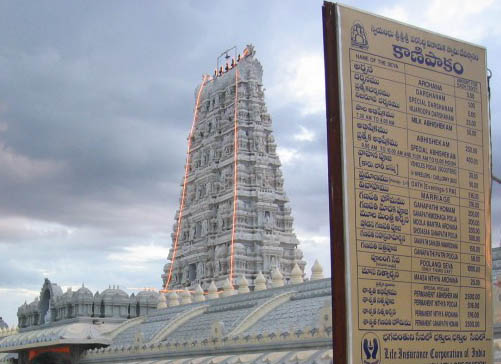Kanipakkam Sri Varasidhi Vinayakar
By Saravanan Iyer
The famous temple of Sri Varasidhi Vinayaka of Kanipakkam is situated on Chittoor - Arakonda Road. Kanipakkam is closer to Karnataka and Tamilnadu state borders.
The word 'Kani' means 'wetland' and 'Parakam' means 'flow of water into the wetland'. This name follows a legend that is connected to the temple.
History[edit]
Once upon a time there lived three farmers, each dumb, deaf and blind by birth respectively. They owned a piece of land and used to do irrigation on the land from a well.
One day they found that the water in the well got dried up and they could no longer continue their job. One of them got into the well and started digging it up.
He was taken aback to see the iron implement hitting a stone like formation. Later, he was shocked to see blood oozing out from it. Within in a few seconds the entire water in the well, turned blood red in colour.
Thus, startled by this divine sight, all the three became normal getting rid of their deformities. As soon as the villagers came to know about this miracle, they thronged to the well and tried to deepen the well further.
But their attempt proved futile because the 'swayambhu' murthi (the self- manifested) of Lord Vinayaka emerged from the swirling waters. But they were not able to dig out the complete murthi fully.
After this miracle, coconuts were offered and the theertham from the coconuts covered the entire area. This led to the modification in the usage of the word 'Kaniparakam' and was later pronounced as 'Kanipakkam'. Even today the murthi is in the original well and the springs of the well are perennial and eternal. During the rainy season, the holy water from the well overflows even today.
Another striking and strange feature of the murthi is that it is still growing in size. At present, we can see only till the knees and the abdomen of the murthi.
Smt. Lakshmamma, an ardent devotee had offered a 'Kavacham' (Armour) to the Lord, 50 years ago but today it is out of size and doesn't fit the murthi. The holy water from the well is offered to the devotees as Theertham.
Bahuda River[edit]
Long ago there lived two brothers Sankha and Likhita. They were on a pilgrimage to Kanipakkam. As the journey was tiring, the younger brother Likhita felt hungry.
Disregarding the advice of the elder brother he plucked a mango from the mango grove. Sankha felt bad and reported this to the ruler of that area and pleaded for punishment for the sin committed during the pilgrimage. Thus Likhita was punished severely being deprived of both arms.
Later they took bath in the river near Kanipakkam temple. Lo Behold! The chopped arms were restored to Likhita as soon as he had a dip in the sacred waters of the river. These incidents led the ruler to rename the river as 'Bahuda' (Bahu means human arm).
Thus the river beside Kanipakkam temple is now known as 'Bahuda River'.
The Up-holder of 'Truth'[edit]
The swayambhu murthi of Kanipakkam is the up-holder of truth. Disputes between people are resolved by taking a 'special oath' in front of Vinayaka.
The people in the dispute take a holy dip in the temple tank and swear before the lord. It is taken as gospel truth. There are instances when the person who committed that sin voluntarily agrees as soon as he had the dip and much before entering the temple itself.
It seems the Lord lawns invisibly on the sinner and makes him repent & feel guilty for his sinful deeds. The promises made in front of the Lord relieves one from errors and protects in times of troubles.
It is a tradition that people living in this place follow only truth.Thus the glory of Sri Varasiddhi Vinayaka spread far and wide and the honourable courts uphold the 'special oath' in their judicial pronouncements.
In this Vinayakar temple, one can see the old manuscripts of the third Kulothunga Chozha and Nedumara varma Sundara Pandiyan's time. Archaeologists say that Kulothunga Chozha should have built this temple in 11th century.
The annual festival, "Brahmotsavam" is held for 20 days commencing from Vinayaka Chaturthi.


